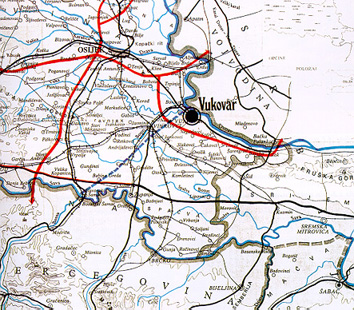
Regional situation map of VUKOVAR and ILOK at right. The important cross-road City of OSIJEK at upper left.
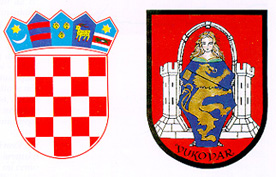
The Republic of CROATIA and the City of VUKOVAR (at right) present official Coat of arms.
VUKOVAR - WOLKOVAR - VUKOVO - CASTRUM WOLCO
General notes on the loess plains of Vukovar and Ilok
The East Croatian plain completely belongs to the Black Sea Danube River's system that is some 450m wide and of 3 to 6m depth at its Croatian stretch. The main tributary to it is Drava River that is 240 to 600m wide and 6 to 8m deep. The longest Croatia's river is Sava having a longitudinal discontinuing profile with many meanders and strong riverbed erosion. The river width varies from 250 to 400m and its depth from 2 to 7 meters. The eastern basins of Drava and Sava rivers show geographic relief similarities with the neighboring Vojvodina's plains. Both regions have negligible dissections and are predominantly created by accumulation processes. There are extensive flooding basins, newly formed shallow troughs and few isolated hillocks like Bansko brdo and Erdutski brijeg. The land reclamation started at the beginning of 19th century reducing the flood areas by more of 50% now.
The East Croatian plain is part of an irregular sink between the Carpathians, the Dinarides and the Alps masses. System of tectonic faults with various activities and ranks border the longitudinal troughs of Drava and Slavonia up to Srijem in NE to EW directions. The whole area was subjected to several denudation processes and sedimentation of limestone and conglomerates that started around mid Miocene. The limy marls and sandstone are of considerable thickness varying between 200 to 1.000 meters. Widest parts of this area are covered fluvial (gravel and sands) and airborne clays, sandy silt and loess whereas some smaller ones have organic sediments. The river plains of Sava, Bosut and their tributaries are predominantly of alluvial with extensive fluvial and swampy areas and a few smaller terraces. There are three main relief types that of the lowland, the shaped plain and the hilly type found at the loess plateaus of Djakovo, Vinkovci, Erdut and Vukovar. Sava River lowland is about 5 meters lower than that one of Drava. Most of the region is less than 90 meters ASL and the loess deposits are 20 to 50 meters thick and the one of Erdutski brijeg is some 60 meters thick dating back to Pleistocene.
* * * * * *

Regional situation map of VUKOVAR and ILOK at right. The important cross-road City of OSIJEK at upper left. |

The Republic of CROATIA and the City of VUKOVAR (at right) present official Coat of arms. |
Reminiscences of a visit in 1999
During our sojourn in Osijek mid September of 1999 our good friend Bruno B. suggested to visit Vukovar and Ilok by car. We left Osijek's eastern downtown Donji Grad ("Lower Town") via the former tollhouse following the tarmac road known as the "Vukovarska cesta" (Vukovar road). I cycled in the same road of stone macadam surface with shoulders of coarse sand on a day trip to Vukovar some 60 years ago. Along this road run drainage trenches beyond those stretched wide cultivated fields as far one could see. Now, everything was so different - fields were overgrown with bushes, high weeds and wild grass! Overgrown mined fields are "no men's land" since the Croatian Home War that started in summer of 1991 to be followed by the conquest of Vukovar City and a prolonged three-sided siege of City of Osijek lasting several years.
At the next road junction there is
one leading eastwards to villages Sarvas, Bijelo Brdo (at the foot of Erdutski
brijeg = mount) and to Erdut village further away. Here it traverses the
Danube River continuing to Bogojevo in Vojvodina (now F.R.Yugoslavia) over
a bridge that was rather important for the aggressor's military from 1991
until 1995. Continuing onwards we bypassed Klisa at left and the former
Osijek airport out of use and overgrown by weeds because of mines now.
I became very depressed by all these sights of absolute abnormality. There
is no sign of any activity around and along our route at all. One must
keep straight onto the road surface at all times because of the mortal
danger if leaving the patched up tarmac. There are thousands of mines led
everywhere in fields, on embankments and in road trenches too. One didn't
start or even attempted to remove any of the thousands of mines led in
vast stretches here yet.
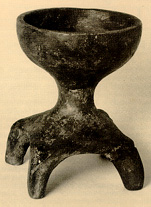 |
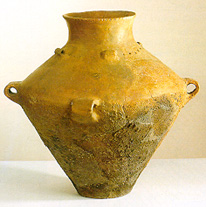
|
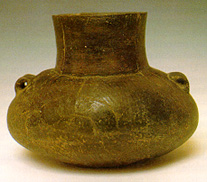 |
Passing a crossroad for villages Vera and Bobota respectively generally sights become more amenable and there are worked on fields onwards. In Trpinja village one doesn't see much of war caused damages but as one draws closer to Borovo the vistas change to worse again. In Borovo there was the biggest industry known as BATA in former Yugoslavia that manufactured rubber tires and footwear etc. All industrial buildings are badly damaged or burned out - through ruined window frames one sees deformed interiors and twisted steel structures of the compound. When we reached Vukovar's northern outskirts dead tree trunks and destroyed or burned out houses were lining the main road at both sides. I've remembered an entirely different same road that one lined with large horse chestnut trees which shadows pleased us much after some 30 km of tiresome bicycling. Between house's empty walls grows weed and wild grass as well as in unkempt gardens amongst trees with hanging and leafless branches. Too many shrapnel impacts on trunks and scorched branches or torn off cannot bear any leaf or fruit in future. A deep sorrow fulness has crept into my heart and I was mourning in spirit after those happy days of 60 years ago.
During my lifetime Vukovar grew to large town extending mostly along the Danube with several multi-storied storied tenancy dwellings linking Borovo Industries compound with New Vukovar suburb. The common solitary one floor or so houses spread westwards along the rivulet Vuka from its confluence in the Danube. At first I wasn't sure whether I was biking on this same road leading to the Old town's center that was situated south of Vuka's confluence. Passing close to the railway station, which was in ruins and overgrown in weeds too, I knew for sure that this tarmac road leads straight to the Old town of Vukovar. Bruno had to turn right some hundred meters later due to a detour following a parallel road flanked with houses in ruins too before retracing back to the main street. There we stopped near the ruins of "NAMA", a former biggest Department Store here, and I got out of car to walk down to Danube's bank alone. The wide river was flowing calmly its waters glistening of midday sunshine. Upstream not far away I could see the Vukovar river harbor's upturned cranes and destroyed quay superstructure - a very busy river port once upon the time. I was pausing lonely and contemplating next to a restaurant seemingly open but no visitor in sight. It was so very quite now - but how must it have been 8 years ago during the war's crescendo?
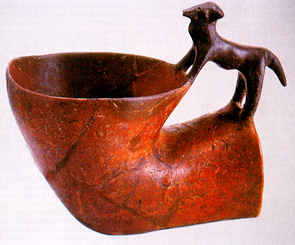
Painted "Ascus" with animal shaped handle from Dalj,
in region of Vukovar. ( AMZ, photo by M.Colic)
Bruno returned with good news that
we could visit the Castle of Counts Eltz of Vukovar. I haven't been in
this two storied castle before but remembered its postcard pictures and
the vast gardens behind a high ironwork enclosure. The mighty castle built
early in 18th century to its former splendor but all of its buildings were
destroyed their plaster peeling of now. Too many impacts of bullets or
splinters of grenades and bombshells hit the whole compound leaving nothing
intact. The castle's walls were densely pockmarked the same as seen around
everywhere despite the UNESCO's plaque marking this complex as the World
Cultural Heritage. The almost intact plague is fixed onto the entrance
stanchion that great ironwork not existing anymore. The almost razed to
grounds Eltz's Caste had accommodated the City Museum of Vukovar with the
Art Gallery branch collection, the Bauer Collection, the Historical Museum
and the Museum of Lavoslav Ruzicka, the Nobel Prize winner. The Yugoslav
army captured Vukovar on November 18, 1991 after the 3 months siege and
constant bombardment that had destroyed the entire city including its Old
Town.
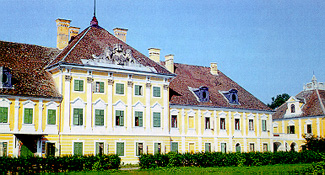
The Counts of Eltz's castle - the north front toward the Danube River around 1980. |
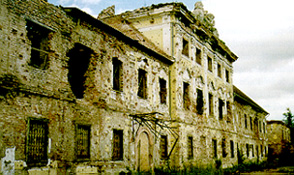
The same north front after the City of Vukovar returned to the Republic of Croatia in 1997. |
I was very frustrated recognizing what an immense monumental heritage was destroyed and what the aggressor plundered of cultural treasures after occupying the City of Vukovar. I was very aggravated seeing what was left of the gardens that were wide open up to the Danube. Every where just dead old tree trunks left between ruins of other castle's buildings flanking at left and right. Only roof of the main building was renewed to protect it of further decay but chimneys were not reconstructed yet. We went inside the main building where few rooms with very modest outfit enabled keeping temporary exhibitions there. A custodian took us to the upper floor via a vast staircase with blank walls except for few marble plaques left showing Counts of Eltz Coat-of-arms or some person's plaque. She unlocked few doors and lead through empty rooms with low ceilings of hardboard panels like the walls to enter in a darkened rather vast hallway. After adjusting to room's dim light I noticed that there is no ceiling up to the roof's under structure. The sudden glow of few hidden lights pointed to a small figurine on a pedestal in a glass casing in the middle of this vastness. Instantly I recognized the VUCEDOL DOVE - a lavishly ingraved bird shaped cult vessel - the Symbol of Peace! I stood as nailed there stunned and downcast contemplating for moments.
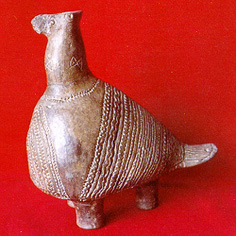
VUCEDOLSKA GOLUBICA (The Dove from Vucedol) - a bird shaped, nicely
engraved
cult vessel found at Gradac (Archeological Museum in Zagreb,
M.Colic).
After visit to the Castle of Counts
Eltz we drove on towards the Old Town passing at the crossroad the late
Baroque corner house and to the core of Old Vukovar. Here the streets were
cleared of rubble but all the houses were in ruins: everywhere rubble between
crumbled walls and none of these venerate buildings had roofs. Bruno parked
his car in front of Vukovar newer Hotel Dunav from where we strolled passing
by the Old Water Tower and the Commercial Bank coming to the Vuka stream
near its confluence to the Danube. Only some pedestrians and tourists moved
around certainly not representing a busy city center at lunchtime at all.
I walked over the Vuka's bridge to get a better view of the White Cross
erected at the Danube promenade commemorating the defenders of Vukovar
1991. The view across Danube was beautiful and so peaceful now but I felt
so very sad about the tragic history of this splendid city of all its times.
I was trying to dash from these very realistic nightmares because my childhood's
romantic reminiscences of Vukovar were vanishing too fast away.
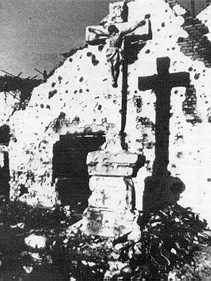
"BECARSKI KRIZ" (= bachelor's cross) next to the Brother Lustig's house in Vukovar (from the Arena photo archives, Zagreb) |
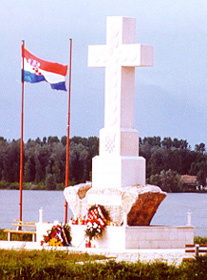
The WHITE CROSS erected to commemorate the Defenders of Vukovar located at Vuka River's conflurence in the Danube River. |
Leaving the Old Town's Baroque area aside we drove the main road onwards to Ilok passing several houses that were repaired and occupied mostly by Serbs recently. A larger number of Serbs stayed in Vukovar after this region returned under Croatia State's jurisdiction in 1998 where as the Croatian returnees still are a few because shortness of proper accommodation and jobs. We stopped at the south access to Vukovar not far away from the former "New" Water Tower that was aggressor's prime target. The tower withstood all the bombarding and strikes and still stands there as the symbol of sufferings of all that drew drinking water from it. Seeing this tower from so near brought to my mind those pictures seen on TV during weeks of brutal fighting and destruction afterwards. The realism of a personal observation is by far more striking and moving than a partial picture appearance on a TV screen or in a newspaper. The skeleton of Vukovar "Yellow" Grammar School stood up on a nearby hill awaiting an urgent repair before the admission of new students.
The nearby Franciscan monastery with St. Philip's and St. Jacob Apostles churches as well as St. John Nepomuk's Chapel were also victims of this fratricidal clash. More than 35.000 museum mobile items were looted and robed by the "Yugoslav National Army" under the patronage of Serb Ministry of Culture and were carried away to Serbia. The most striking examples of this cultural artifact plunder are those from St. Jacob Apostles Church and the Library of Vukovar. The Museum Documentation Center of Croatia has a definite list of art treasures from 80 odd museums, archives, various memorial centers, local collections and galleries that disappeared during the recent aggression. The Croatian Authorities know, in most cases, the whereabouts of collections and archives like the Bauer Collection from Vukovar City Museum that is kept in the museums of Novi Sad and Belgrade and in the Archives of Vojvodina. The Bauer collection includes among 1357 registered objects d'art among others of V.Bukovac, C.Medovic, I.Krsnjavi, Ivan Mestrovic, F.Krisinic, E.Vidovic and Ljubo Babic etc.
The documentation, photographs and other material looted from the Jasenovac Memorial Center are kept in Bosanska Krupa (Republika Srpska of B&H). There are more archives and films as well as historic data and documentation relating to the period from 1918 to 1990 (that includes those of Independent State of Croatia alias "NDH" from 1941/5) that still kept by the present Yugoslav Authorities. This rich cultural and historical heritage of immense treasure has to be returned to Croatia sometimes and it must become the matter of restitution and subject of discussion within the framework of the Succession project. I was getting dizzy about Bruno's narration about these atrocities and war crimes and plunders that occurred in Eastern Croatia regions. I asked him for some respite but instead he offered showing us the new cemetery of Vukovar where one reburied the too many war victims including those from the "Ovcara" hidden gully.
Leaving Vukovar we passed the city's former south toll station where sever fights raged for many days during the defense battle in fall of 1991. Few kilometers down the main road we turned of to visit Vukovar's new cemetery where the victims of aggression and occupancy were laid to rest including those who were massacred at the "Ovcara". For years one speculated what had happened to some 200 wounded male civilians and defenders who were abducted from the War hospital after the defense of Vukovar failed on November 19, 1991. The Yugoslav authorities ordered all elderly persons, women and children to leave Vukovar instantly. Some were marched over mine fields to the Croatian side towards Nustar and other selected ones were driven of to an unknown destination somewhere in Serbia. At the same time a high rank officer of the Yugoslav Army (YA) refuted IRC request of taking over all the wounded persons from the hospital and their destiny remained a mystery for years. Then in 1995 one man from Vukovar, who escaped injured the massacre, told about what happened to those wounded persons snatched from the Hospital describing the place were they were buried secretly far out from any view.
Some 5km further onwards we turned right onto a field earthen road that bypassed a few of agricultural stations that were Counts of Eltz's former property. This side road passed between fields, few coppices and across dry gullies until we turned of sharp left onto an even smaller earthen road at the signboard reading "Ovcara". We followed that path along a thicket with a dry brook deep inside until we came to a wider clearing as a parking lot from that a narrow footpath leads to the OVCARA PIT. Memorial tombstone stands next to the former pit where the international forensic team has exhumed about 200 person all of that were the injured ones abducted from Vukovar. This was the place where the aggressor hid those abducted from the hospital, killing by cold weapons or firearms and burying them in an most inconspicuous pit in a field close to a thicket far away from any possible viewer. Now, at the leveled pit area is surfaced with white fine gravel and 200 evergreen bushes were planted as the memorial for victims of the most outrageous of war crimes done by the aggressor on Croatian lands.
I was so deeply distressed grieving about what has happened in recent Croatian history that I had to turn my attention to the unobtrusiveness of the place that we were to leave. Soon after we returned to the main road [7] continuing to Ilok passing through village of Sotin. Here the Croatian returnees, still dressed in black, ask about the destiny of their missing members from their Serb neighbors at daily rallies - though in vain up to now.
Leaving Sotin village the road forks: the right one leads to Tovarnik and to the border crossing to Sid in Serbia and the other one continues straight to Ilok. It ascends gradually on the loess ridge that gradually rises along Danube's right bank getting to the Fruska gora (= mountain) further of Ilok in Eastern Srijem of province of Vojvodina. We passed through the old Croatian villages of Opatovac and Mohovo on the tarmac road that has several sharp turns with ups and downs to transverse a few dry ravines cut in the loess ridge by torrents. Soon came into view the next village Sarengrad (= Speckled Town).
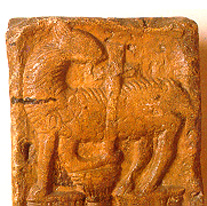
* * * * * *
Note 1: Please read more about
the sojourn at the web page titled as VUKOVAR and ILOK (Part 2/2)
and subtitled ILOK - VJOLK - WYLOK.
Note 2: See also the web
page REGIONAL HISTORY of VUKOVAR and ILOK.
* * * * * *
Main sources of data and pictures:
1. VUKOVAR - ETERNAL CROATIAN
TOWN ON THE DANUBE by Editor in Chief: Igor Karaman; Editorial Board:
Dragutin Feletar, Vlado Horvat, Josip Jurcevic, Zlatko Karac, Nives Majnaric-Pandzic,
Ruzia Maric, Filip Potrebica & Zeljko Tomicic. Publisher: NAKLADNA
KUCA "DR. FELETAR" Koprivnica - Croatia, Trg mladosti 8. ISBN: 953-6235-00-5.
2. DVORCI I PERIVOJI U SLAVONIJI
(Castles
and parks in Slavonia) by Mladen Obad Scitaroci and Bojana Bojanic Obad
Scitaroci. Publisher: MLADEN OBAD SCITAROCI, Zagreb 1998.
3. BORDERS OF CROATIA ON MAPS
from 12th to 20th century published by The Museum of Arts and Crafts Zagreb.
* * * * * *